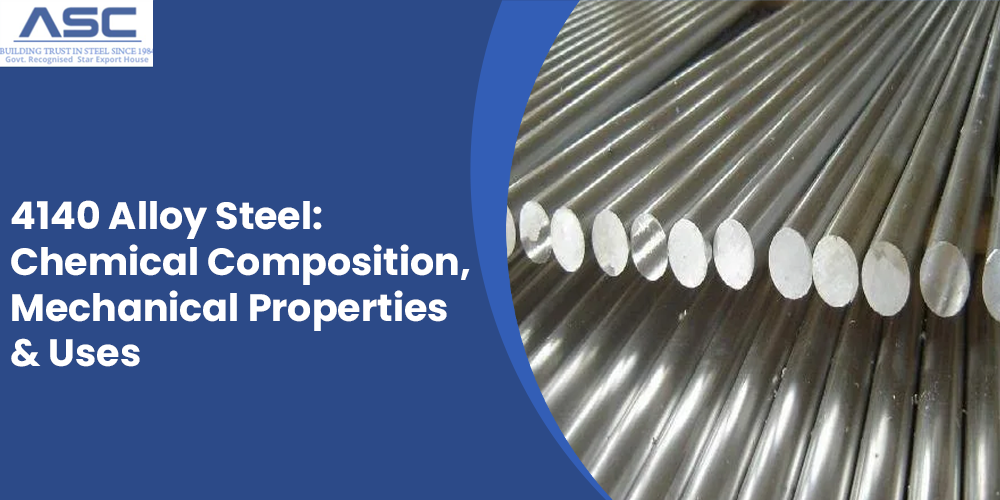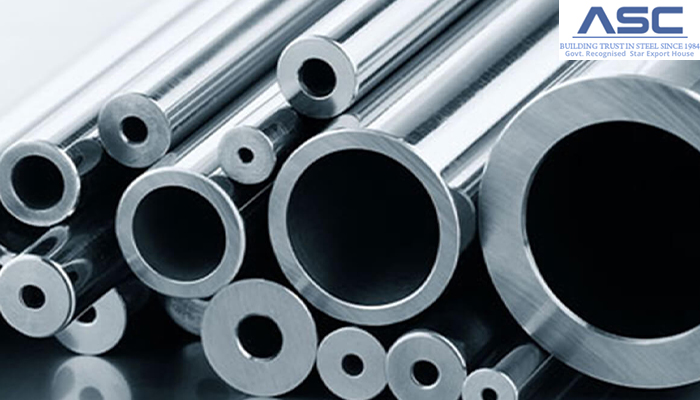4140 Alloy Steel: Chemical Composition, Mechanical Properties & Uses
by AMC
Posted on July 01, 2024 at 12:40 PM

4140 alloy steel is widely recognized for its versatility and widespread application in numerous industries. It is classified as a low-alloy steel, alloyed primarily with chromium and molybdenum, which impart specific properties crucial for its performance in demanding environments. Here are some key characteristics and applications of 4140 alloy steel:
- Composition: 4140 steel contains chromium and molybdenum as alloying elements, which enhance its hardness, toughness, and overall mechanical properties.
- Strength and Toughness: Known for its exceptional toughness, 4140 alloy steel exhibits high torsional and fatigue strength. This makes it ideal for applications where components are subjected to heavy stresses and strains, such as axles and shafts in machinery and automotive sectors.
- Versatility: Available in various forms, including bars, 4140 steel is particularly favored in its bar form due to its ease of machining and suitability for heat treatment processes that further enhance its properties.
What is 4140 Alloy Steel?
4140 alloy steel, like all steels, is mainly composed of iron. It is alloyed with carbon, chromium, molybdenum, and other minor components, making it a type of "chromoly" steel. Known for its toughness, 4140 alloy steel is resistant to wear and corrosion.
What is 4140 Alloy Steel Used For?
4140 alloy steel is commonly used for components that endure high stress, such as axles, drive shafts, crankshafts, spindles, and gears. It is also ideal for static components like bolts and chain links that operate under heavy loads. Its high tensile strength, toughness, and torsional strength make 4140 alloy steel well-suited for these applications.
How is 4140 Alloy Steel Made?
4140 alloy steel is manufactured using either an electric furnace or a basic oxygen furnace. The base alloy components are added and melted together at temperatures exceeding 1500 °C. Once melted, the steel is tapped off from the furnace and allowed to cool.
The cooling process includes annealing, which involves controlled heating and gradual cooling to refine the steel's properties. After annealing, the steel undergoes a process to remove mill scale by dipping it in hydrofluoric acid.
The steel is then melted again and cast into billets or slabs. These are shaped to their final dimensions through hot-working or cold-working processes, often using rollers.
AISI 4140 Alloy Steel Chemical Composition
| Element | Content (%) |
|---|---|
| Chromium, Cr | 0.80 - 1.10 |
| Manganese, Mn | 0.75 - 1.0 |
| Carbon, C | 0.380 - 0.430 |
| Silicon, Si | 0.15 - 0.30 |
| Molybdenum, Mo | 0.15 - 0.25 |
| Sulfur, S | 0.040 |
| Phosphorous, P | 0.035 |
| Iron, Fe | Balance |
Carbon Content of 4140 Alloy Steel
4140 alloy steel contains approximately 0.38-0.43% carbon. This places it in the category of medium-carbon steels, as low-carbon steels typically have less than 0.3% carbon content.
AISI 4140 Steel Physical Properties
| Properties | Metric | Imperial |
|---|---|---|
| Density | 7.85 g/cm3 | 0.284 lb/in³ |
| Melting point | 1416°C | 2580°F |
AISI 4140 Alloy Steel Mechanical Properties
| Properties | Metric | Imperial |
|---|---|---|
| Tensile strength | 655 MPa | 95000 psi |
| Yield strength | 415 MPa | 60200 psi |
| Bulk modulus (typical for steel) | 140 GPa | 20300 ksi |
| Shear modulus (typical for steel) | 80 GPa | 11600 ksi |
| Elastic modulus | 190-210 GPa | 27557-30458 ksi |
| Poisson's ratio | 0.27-0.30 | 0.27-0.30 |
| Elongation at break (in 50 mm) | 25.70% | 25.70% |
| Hardness, Brinell | 197 | 197 |
| Hardness, Knoop (converted from Brinell hardness) | 219 | 219 |
| Hardness, Rockwell B (converted from Brinell hardness) | 92 | 92 |
| Hardness, Rockwell C (converted from Brinell hardness. Value below normal HRC range, for comparison purposes only) | 13 | 13 |
| Hardness, Vickers (converted from Brinell hardness) | 207 | 207 |
| Machinability (based on AISI 1212 as 100 machinability) | 65 | 65 |
Thermal Properties of 4140 Alloy Steel
| Properties | Metric | Imperial |
|---|---|---|
| Thermal expansion coefficient (@ 0-100°C/32-212°F) | 12.2 µm/m°C | 6.78 µin/in°F |
| Thermal conductivity (@ 100°C) | 42.6 W/mK | 296 BTU in/hr.ft².°F |
AISI 4140 Equivalent Material
| USA | German | Japan | China | ISO |
|---|---|---|---|---|
| ASTM 29/A29M | DIN 17350 | JIS G4404 | GB/T 1229 | ISO 683/18 |
| 4140 | 1.7225/42CrMo4 | SCM440 | 42CrMo | 42CrMo4 |
Common Forms of 4140 Alloy Steel
4140 alloy steel is available in various forms, each serving specific purposes:
- Sheet: Cold-rolled into sheets ranging from 1 to 10 mm thick.
- Bar: Manufactured in flat, square, and round cross-sections. Square and round bars are typically available in sizes from 6 mm up to 120 mm.
- Plate: Cold-rolled into plates, with thicknesses typically ranging from 20 to 120 mm, but can go up to 300 mm. Different finishes, including annealed, are available.
- Hot Rolled: Available as hot-rolled bars in flat, round, hexagonal, and square shapes. Hot-rolled bars have a distinct surface finish and may have slightly lower strength compared to cold-rolled forms.
- Annealed: Often purchased in the annealed state to enhance ductility for subsequent cold forming into bars or plates.
- Cold Drawn: Cold-drawn into flat, round, and square bars after annealing to improve ductility with a softer pearlite microstructure.
Advantages & Disadvantages of Using 4140 Alloy Steel
Advantages
- Very good fatigue strength, high tensile strength, and high torsional strength.
- Wear-resistant properties.
- Easily hardened through heat treatment.
- Excellent corrosion resistance due to chromium and molybdenum content.
Disadvantages
- Difficult to weld effectively; weldability depends on thermal treatment.
- Welding is typically recommended only on annealed material.
- Requires preheating before welding and often necessitates slow cooling and subsequent heat treatment post-welding.
Fabrication and Heat Treatment of AISI 4140 Alloy Steel
Machinability:
- AISI 4140 alloy steel is easily machinable in its annealed condition.
Forming:
- It has high ductility and can be formed using conventional techniques, though it requires more force due to its toughness compared to plain carbon steels.
Welding:
- Welding can be done using standard methods. However, welding in the heat-treated condition affects its mechanical properties, requiring post-weld heat treatment.
Heat Treatment:
- Heating AISI 4140 to 845°C (1550°F) and quenching in oil is typical for hardening.
- Normalization involves heating to 913°C (1675°F) followed by air cooling before hardening.
Forging:
- Forging is done at temperatures ranging from 926 to 1205°C (1700 to 2200°F).
Hot Working:
- Hot working temperature ranges from 816 to 1038°C (1500 to 1900°F).
Cold Working:
- Conventional cold working methods can be applied in the annealed condition.
Annealing:
- Annealing is carried out at 872°C (1600°F), followed by slow cooling in the furnace.
Tempering:
- Tempering temperatures range from 205 to 649°C (400 to 1200°F), depending on desired hardness. Lower tempering temperatures result in higher hardness.
Hardening:
- Hardening can be achieved through cold working or heating followed by quenching.
Difference Between 4140 Alloy Steel and 8620 Steel:
- 4140 Alloy Steel: Contains higher carbon content and chromium-molybdenum alloying elements. It is known for its high strength, toughness, and resistance to wear and corrosion.
- 8620 Steel: Slightly lower carbon content and includes nickel. It shares similar proportions of chromium and molybdenum with 4140 alloy steel. 8620 steel is often used for case hardening through carburization.
Difference Between 4140 Alloy Steel and 1045 Steel:
- 4140 Alloy Steel: Chrome-molybdenum alloy with excellent strength, toughness, and corrosion resistance. Commonly used in industrial applications requiring high performance.
- 1045 Steel: Medium-carbon steel with lower alloy content compared to 4140. It has good tensile strength but is less resistant to wear and corrosion than 4140 alloy steel.
Summary: 4140 Alloy Steel
This article provided an overview of 4140 alloy steel, detailing its composition and characteristics. 4140 alloy steel is a chrome-molybdenum steel known for its high strength, toughness, wear resistance, and corrosion resistance. It contains carbon, chromium, molybdenum, and other alloying elements.
Applications of 4140 alloy steel include components subjected to high stress and wear, such as axles, crankshafts, gears, and bolts. It is available in various forms like sheets, bars, plates, and can be processed through heat treatment for optimal performance.
For further information on 4140 steel, readers are encouraged to contact a representative at Amardeep Steel.

Alloy Steel - Properties, Types, Uses & Grades
Alloy steel is a type of steel that is mixed with other elements like molybdenum, manganese, nickel, chromium, vanadium, silicon, and boron.

.jpg)